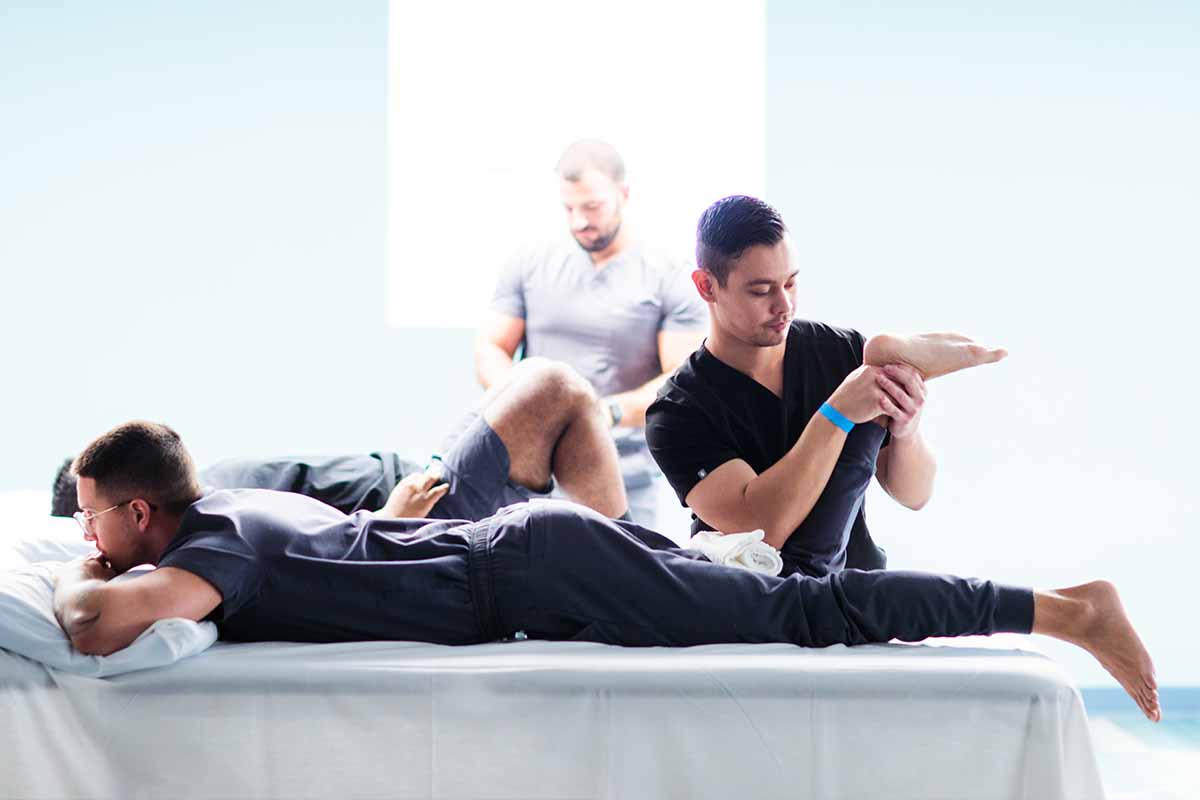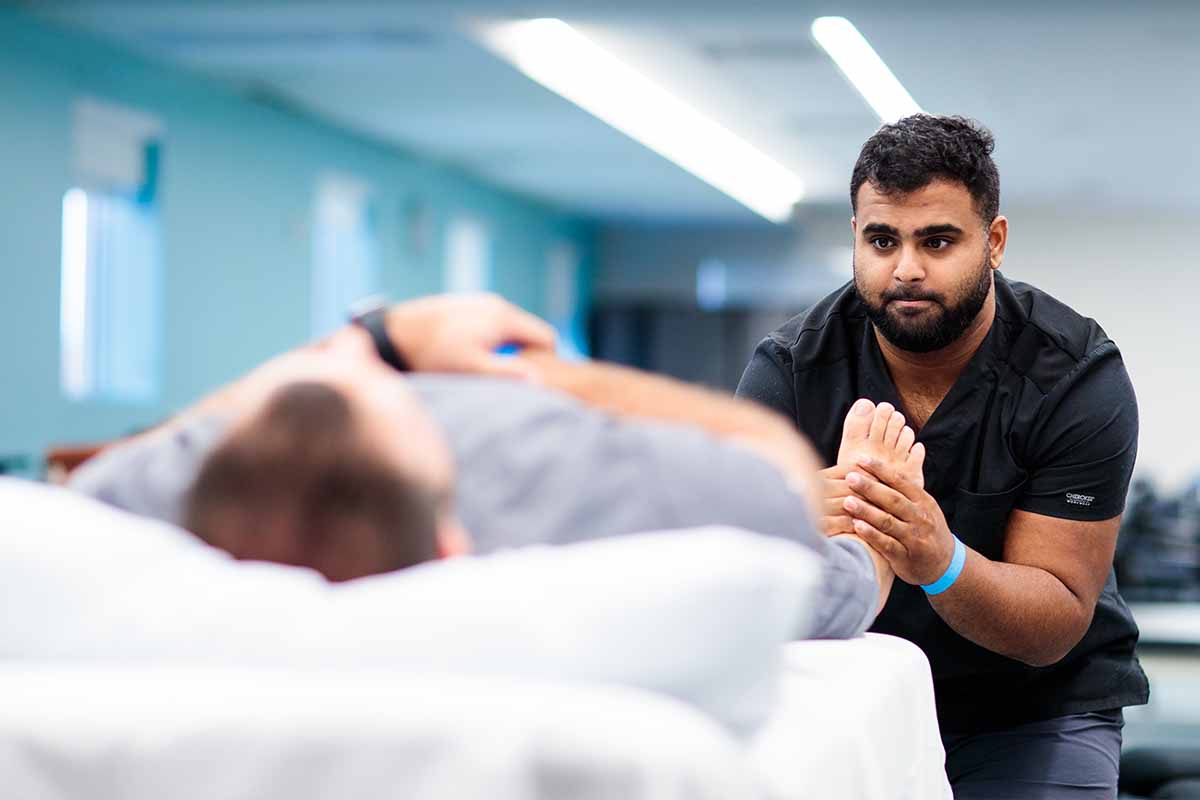
“Sit up straight!” How to improve posture isn’t just an annoying thing our parents and teachers taught us—it’s good for our health. The term posture refers to the position in which we hold our bodies. We rely on our postural muscles to maintain balance, prevent the forces of gravity from pushing us forward and move in ways that place the least strain on supporting muscles and ligaments.1
Many of us spend our entire workday in a relatively static position, so our bodies must be positioned correctly. Let’s review the benefits of good posture. We’ll also offer posture exercises to help you get fit and improve posture at work.
What Happens to Your Body When You Have Good Posture?
Numerous factors can contribute to poor posture, including tight or weak muscles, stress, obesity and wearing unsupportive shoes. Poor posture can lead to back and neck pain, breathing problems and headaches—and may even impact mood.2
It’s important to recognize that good posture can profoundly impact your health, well-being and ability to thrive at work. Improvement may provide the following benefits of good posture:
1. Increased Confidence
Correct posture can impact the way you feel about yourself. When you hold an upright, confident posture you’re more likely to have confidence in your thinking.3 Feeling more empowered in your ideas at work will ultimately help you succeed.
2. More Energy
Poor body alignment can negatively affect energy levels, resulting in fatigue. Practicing proper posture may help you remain focused and energized at work.4 Whether you’re delivering packages or caring for patients, correct posture can allow you to power through the day more easily.
3. Greater Self-Esteem and Better Mood
In addition to giving you more energy, the benefits of good posture can also include improving your self-esteem and mood.5 Feeling good about your professional life often starts with feeling positive about yourself.
4. Easier Breathing
One of the benefits of good posture is that it becomes easier to breathe.6 Slouching can reduce lung capacity, leading to shortness of breath. Having difficulty breathing can impact your ability to do your best work. To breathe more life into your lungs and career, try altering your posture.
5. Less Frequent Headaches

Bad posture creates tension in the upper back, neck and shoulders, leading to headaches that manifest as throbbing pain in the base of the skull and sometimes the forehead.7 Headaches are no fun, so this is an incentive to learn how to improve posture.
6. Reduced Risk of Injury
Another one of the benefits of good posture is injury prevention, especially to your back, shoulders, arms and wrists. One of the most common reasons people see a doctor or seek emergency care is back pain.8 It’s important to have good standing posture, as standing for long periods with restricted body positions, for example, while working, can create short-term adverse health issues.9
7. Boosted Productivity
Research shows that posture impacts productivity.10 If you’re in pain, injured or fatigued, or lack self-confidence, you will likely have trouble staying focused and productive at work. Since good posture can positively impact your mental and physical health, it enables you to be a more productive team member.
How to Improve Posture at Work
Staying active, maintaining a healthy weight, being mindful of body positioning and adding strengthening exercises to your routine can improve posture.
Below, we illustrate how to improve posture in various work environments to help foster a healthier mind-body connection that supports productivity.
If You Sit at a Desk All Day
If you work at a desk all day, especially if you type on a keyboard, setting up an ergonomically correct workstation is critical for proper posture and maintaining the health of your back, shoulders, arms and wrists.
Ideally, your desk should be slightly below elbow level so your forearms and wrists can stay parallel to the floor when typing. Be sure that your shoulders are relaxed, not hunched. Typing with poor posture and ergonomics can cause various types of repetitive strain injury, such as carpal tunnel syndrome.11 These conditions can affect not just the wrists but the whole upper body. They are painful and can be difficult to treat, so it’s important to nip them in the bud and focus on how to improve posture instead.
People who work desk jobs may also have an increased risk of health problems from being too sedentary, so be sure to balance your sitting time with regular exercise.12
Exercises to Improve Posture As You Are Sitting
Try the exercises below, which you can do at your desk, to improve posture while sitting.
Chin tucks: You can do this exercise at your desk. It helps relieve neck pain while improving the neck’s strength, flexibility and function.
- Sit upright and look straight ahead.
- Pull the chin down toward the chest.
- Hold for 5 seconds, then release.
- Repeat 10 times or as tolerated.
Single leg extension: You can do this exercise at home or at your desk. It will help train your core muscles to keep your pelvis stabilized.
- Sit upright in a chair with your feet planted on the floor, hip-width apart.
- Lift one leg to a horizontal position.
- Return to the starting position.
- Do sets of 10 reps or as tolerated.
- Repeat with the other leg.


If You’re Behind the Wheel All Day
In addition to causing back pain and headaches, driving in an incorrect position can also increase your risk for serious injury behind the wheel. Knowing how to improve posture when you drive can save your life.13
Exercises to Improve Posture While Driving
Try the following exercises to improve posture while driving and remain pain-free while making deliveries, transporting others or traveling all day:
Shoulder blade squeeze: This exercise helps reduce pressure on the neck and shoulders.
- With your hands on the steering wheel, bring your shoulder blades back and up.
- Squeeze your shoulder blades together as if you’re trying to squeeze a pencil in the middle of your back.
- Hold for 3 seconds, then release.
- Repeat 10 times or as tolerated.
Seated pelvic tilt: This exercise activates the abdominal and external oblique muscles and can help improve posture.
- Press your lower back into the car seat.
- Inhale and tilt your pelvis forward to create an arch in your lower back.
- Hold for 3 seconds, then release.
- Repeat 10 times or as tolerated.
If You’re on Your Feet All Day
Studies have shown that prolonged standing activities may contribute to lower extremity and back disorders.14 Given these risks, it’s important to know how to improve posture while standing.
Exercises to Improve Posture When Standing
Try the following exercises to improve posture and relieve pain while standing so that you’re prepared to teach class, treat patients, or guide tours comfortably:
Bear hug: This stretch relieves tight shoulders and tension in the neck and back.
- Wrap your arms around your body as if you’re hugging yourself.
- Increase the stretch by holding onto your shoulders and pulling.
Calf raises: This exercise strengthens the calf muscles, which will help to support your ankles and feet.
- Rest your hands against a wall or sturdy object.
- Raise the balls of your feet so that your heels are off the ground.
- Hold for a few seconds, then return to the starting position.
If You Do a Lot of Heavy Lifting
Ergonomics is one of the leading causes of injury in the workplace.15 Knowing how to improve posture when lifting things can help you avoid injury and pain.
Exercises to Improve Lifting Posture
Try the following exercises to improve posture when lifting heavy items:
Squat: This exercise strengthens your knees and hips while increasing flexibility.
- Stand with your feet slightly wider than your hips and point your toes slightly outward.
- Keep your core tight and chest up, and then squat down by pushing your knees to the side and moving your hips back.
- Pause in the squat, then return to the starting position.
Lower trunk rotation: Increases flexibility in the lower back and hips, allowing for greater mobility in the spine.
- Start by lying on your back with your knees bent and your feet flat on the floor.
- Keep your feet on the floor and allow your knees to fall to one side of your body.
- Using your abdominal muscles, move your legs to the opposite side.
- Repeat 5 to 10 times on each side.
If you continue to struggle with good posture or chronic pain, you might consider working with a physical therapist (PT). A physical therapist will treat your pain and help you prevent further injury by regaining your range of motion. Your PT will offer additional exercises to strengthen the muscle groups you need to achieve the optimal posture for your body. Your PT might also recommend you wear a posture corrector, especially if you have back problems that prevent you from doing the correct pose yourself. Whether you need a posture corrector or not, what’s important is that having a good posture can help avoid health implications due to posture problems.
Sources
- American Chiropractic Association, “Maintaining Good Posture,” ACA, 2025, https://www.acatoday.org/patients/posture/.
- “Staying Healthy: 3 surprising risks of poor posture,” Harvard Health Publishing, July 20, 2023, https://www.health.harvard.edu/staying-healthy/3-surprising-risks-of-poor-posture.
- Selig, M., “Heads Up! Good Posture Helps Both Your Mind and Your Body,” Psychology Today, May 8, 2024, https://www.psychologytoday.com/intl/blog/changepower/202212/heads-good-posture-helps-both-your-mind-and-your-body.
- Ruben Castaneda, “The Health Risks of Poor Posture,” U.S. News & World Report, May 31, 2023, https://health.usnews.com/wellness/slideshows/ways-bad-posture-can-harm-your-health?slide=4.
- Travers, M. “3 Unexpected Benefits Of Good Posture On Mental Health, By A Psychologist,” Forbes, September 24, 2024, https://www.forbes.com/sites/traversmark/2024/09/24/3-unexpected-benefits-of-good-posture-on-mental-health-by-a-psychologist/.
- Wheeler, T., “What You Should Know About the Benefits of Good Posture,” July 21, 2023, https://www.webmd.com/fitness-exercise/what-you-should-know-about-benefits-good-posture.
- National Health Service, “10 headache triggers,” NHS, April 17, 2024, https://www.nhs.uk/conditions/headaches/10-headache-triggers/.
- Casiano, V., et al., “Back Pain,” National Library of Medicine, National Center for Biotechnology Information, December 11, 2023, https://www.ncbi.nlm.nih.gov/books/NBK538173/.
- “Working in a Standing Position,” Canadian Centre for Occupational Health and Safety, May 10, 2024, https://www.ccohs.ca/oshanswers/ergonomics/standing/standing_basic.html.
- Wang, H., et al., “Quantifying the impacts of posture changes on office worker productivity: an exploratory study using effective computer interactions as a real-time indicator,” BMC Public Health, November 8, 2023, https://bmcpublichealth.biomedcentral.com/articles/10.1186/s12889-023-17100-w.
- “Carpal tunnel syndrome,” Mayo Clinic, February 6, 2024, https://www.mayoclinic.org/diseases-conditions/carpal-tunnel-syndrome/symptoms-causes/syc-20355603.
- Aliouche, H., “What are the Health Implications of Office Jobs?,” News Medical Life Sciences, January 19, 2023, https://www.news-medical.net/health/What-are-the-Health-Implications-of-Office-Jobs.aspx.
- Robert Edbrooke, “Why Your Driving Posture Matters,” Geico, 2025, https://living.geico.com/driving/auto/car-safety-insurance/posture/.
- Hoon Jo, et al. “Negative Impacts of Prolonged Standing at Work on Musculoskeletal Symptoms and Physical Fatigue: The Fifth Korean Working Conditions Survey,” Yonsei Medical Journal, May 14, 2021, 62(6):510–519, https://pmc.ncbi.nlm.nih.gov/articles/PMC8149936/.
- Occupational Safety and Health Administration, “Solutions for Electrical Contractors,” U.S. Department of Labor, 2025, https://www.osha.gov/etools/electrical-contractors.











